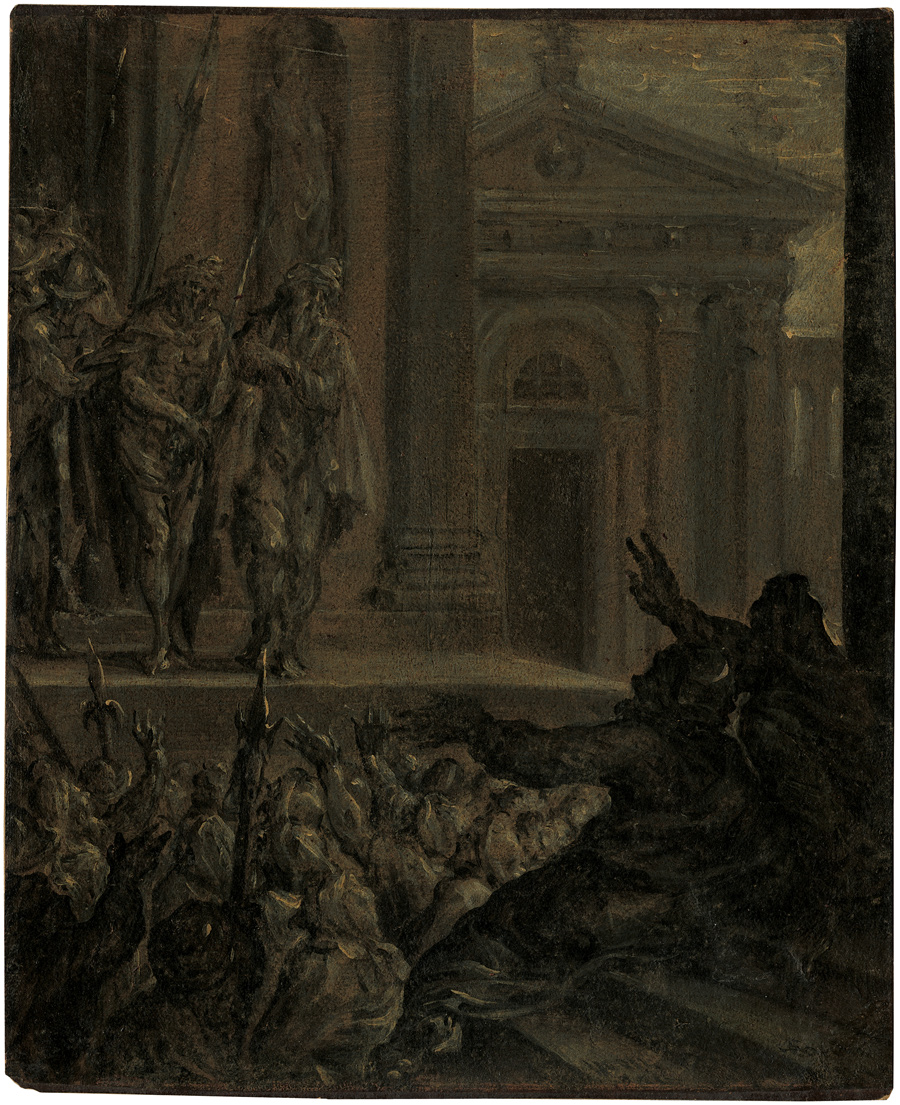Loading the page ...
Dirck Barendsz.
(1534–1592, Amsterdam)
Ecce Homo (John, 19:5). Oil on paper. 25.3 x 20.7 cm. Monogrammed: Th.B.
The very fact that Dirck Barendsz. worked in Venice between 1555 and 1562 under none other than Titian makes him an outstanding figure in the spectrum of 16th century Dutch art. We owe this knowledge to Carel van Mander, who also pointed out the close relationship between master and pupil. Following his return from Italy, Barendsz. began his creative career in Amsterdam, where his Venetian experiences must have considerably enhanced his prestige in his home town. Contemporary sources depict Barendsz. as a wealthy and widely educated man who associated with some of the outstanding minds of his epoch, such as the poet and statesman Marnix van Sint Aldegonde and the humanist Domenicus Lampsonius, his approximate coeval.
Despite Barendsz.’ prolific creativity only few of his paintings have been preserved. The rare known works show him to have been an important intermediary between the Italian and Nordic traditions. Some of his compositions have survived in the form of engravings by Johannes Sadeler and Hendrick Goltzius, which has aided the reconstruction of his œuvre. Of eminent importance for a better understanding of his style of painting is this brilliantly executed oil sketch belonging to a group of about forty works on the Passion of Christ, all done in this technique. The cycle was first described in the 18th century by Pierre-Jean Mariette in the Abécédario, where it was associated with Johannes Sadeler I, who made five engravings after these modelli (Hollstein 201–205). The cycle was still preserved in its entirety around the middle of the 19th century, when the Louvre in Paris was invited to purchase it. The transaction fell through, however, and the series was dispersed. It was not until 1978 that Jacques Foucart and Pierre Rosenberg published seven works from the Passion series ("Some ‘Modelli’ of Religious Scenes by Dirck Barendsz.", Burlington Magazine, CXX, 1978, pp. 198–204). In 1991 Felice Stampfle was able to prove the existence of a total of twenty-four oil studies of this cycle, which are now to be found mainly in well-known museum collections (Netherlandish Drawings of the Fifteenth and Sixteenth Centuries and Flemish Drawings of the Seventeenth and Eighteenth Centuries in the Pierpont Morgan Library, New York 1991, pp. 16–17, no. 28). At the time of writing, twenty-seven oil sketches, including the present new discovery, are known to be in existence (see Marijn Schapelhouman in: Netherlandish Art in the Rijksmuseum 1400–1600, Amsterdam 2000, p. 209, no. 89).
The present Ecce Homo magnificently demonstrates Barendsz.’ technical mastery and stylistic verve. On a narrow platform protruding from some ancient edifice stands the figure of Christ with a crown of thorns, bearing a rod and being presented by two soldiers to the baying crowd. In the right half of the picture we see a temple façade reminiscent of Palladio’s sacred Venetian buildings. Two animatedly gesticulating rear-view figures sitting on a flight of steps serve as a repoussoir and lend depth and space to the very compact and concentrated composition. Barendsz.’ highly individual painting style shows synthetic mastery and spareness. With a few accurate brush strokes the artist succeeds in presenting a complex of figures in a convincing three-dimensional manner. The eerie, flickering light is reminiscent of the mature Titian and the art of Tintoretto. In this respect Barendsz. is unique in the artistic milieu of his day. Who else among his Dutch contemporaries would have been capable of suggesting such a degree of pathos and sweeping movement on such a small format? The delicate monochrome gradations of the brush are appropriate to the drama of the scene and enhance the three-dimensional chiaroscuro effect. The result is a devotional picture of great emotional intensity.
Apart from minor aging the sketch is excellently preserved and mounted on a 19th century paper backing with a barely legible inscription written in pen and ink on the verso: "..d’un Album disposé par Charles Quint...".
